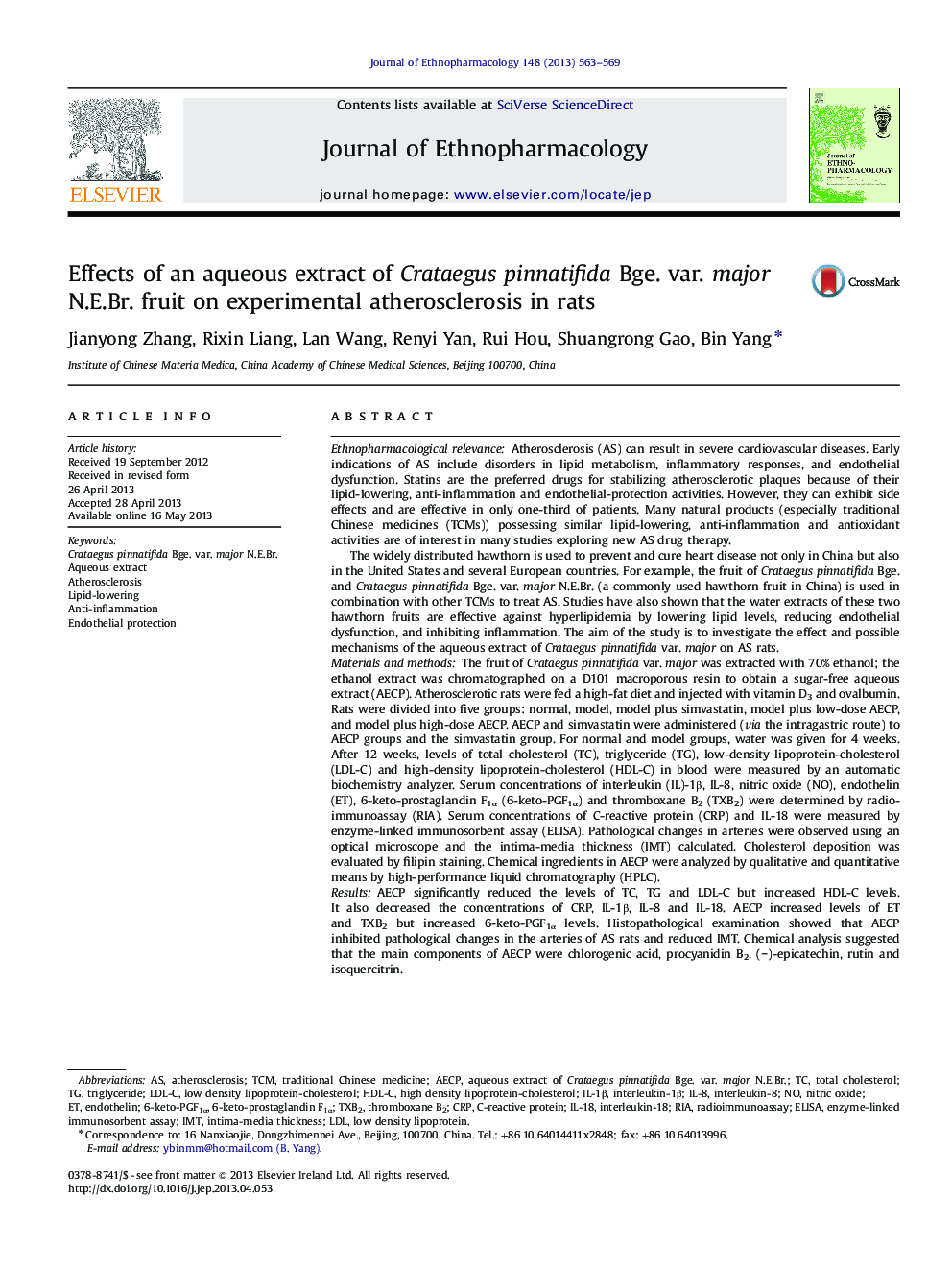| کد مقاله | کد نشریه | سال انتشار | مقاله انگلیسی | نسخه تمام متن |
|---|---|---|---|---|
| 5837152 | 1123958 | 2013 | 7 صفحه PDF | دانلود رایگان |

Ethnopharmacological relevanceAtherosclerosis (AS) can result in severe cardiovascular diseases. Early indications of AS include disorders in lipid metabolism, inflammatory responses, and endothelial dysfunction. Statins are the preferred drugs for stabilizing atherosclerotic plaques because of their lipid-lowering, anti-inflammation and endothelial-protection activities. However, they can exhibit side effects and are effective in only one-third of patients. Many natural products (especially traditional Chinese medicines (TCMs)) possessing similar lipid-lowering, anti-inflammation and antioxidant activities are of interest in many studies exploring new AS drug therapy.The widely distributed hawthorn is used to prevent and cure heart disease not only in China but also in the United States and several European countries. For example, the fruit of Crataegus pinnatifida Bge. and Crataegus pinnatifida Bge. var. major N.E.Br. (a commonly used hawthorn fruit in China) is used in combination with other TCMs to treat AS. Studies have also shown that the water extracts of these two hawthorn fruits are effective against hyperlipidemia by lowering lipid levels, reducing endothelial dysfunction, and inhibiting inflammation. The aim of the study is to investigate the effect and possible mechanisms of the aqueous extract of Crataegus pinnatifida var. major on AS rats.Materials and methodsThe fruit of Crataegus pinnatifida var. major was extracted with 70% ethanol; the ethanol extract was chromatographed on a D101 macroporous resin to obtain a sugar-free aqueous extract (AECP). Atherosclerotic rats were fed a high-fat diet and injected with vitamin D3 and ovalbumin. Rats were divided into five groups: normal, model, model plus simvastatin, model plus low-dose AECP, and model plus high-dose AECP. AECP and simvastatin were administered (via the intragastric route) to AECP groups and the simvastatin group. For normal and model groups, water was given for 4 weeks. After 12 weeks, levels of total cholesterol (TC), triglyceride (TG), low-density lipoprotein-cholesterol (LDL-C) and high-density lipoprotein-cholesterol (HDL-C) in blood were measured by an automatic biochemistry analyzer. Serum concentrations of interleukin (IL)-1β, IL-8, nitric oxide (NO), endothelin (ET), 6-keto-prostaglandin F1α (6-keto-PGF1α) and thromboxane B2 (TXB2) were determined by radioimmunoassay (RIA). Serum concentrations of C-reactive protein (CRP) and IL-18 were measured by enzyme-linked immunosorbent assay (ELISA). Pathological changes in arteries were observed using an optical microscope and the intima-media thickness (IMT) calculated. Cholesterol deposition was evaluated by filipin staining. Chemical ingredients in AECP were analyzed by qualitative and quantitative means by high-performance liquid chromatography (HPLC).ResultsAECP significantly reduced the levels of TC, TG and LDL-C but increased HDL-C levels. It also decreased the concentrations of CRP, IL-1β, IL-8 and IL-18. AECP increased levels of ET and TXB2 but increased 6-keto-PGF1α levels. Histopathological examination showed that AECP inhibited pathological changes in the arteries of AS rats and reduced IMT. Chemical analysis suggested that the main components of AECP were chlorogenic acid, procyanidin B2, (â)-epicatechin, rutin and isoquercitrin.ConclusionsThese data suggest that AECP can inhibit AS progression in high-fat-diet-fed rats. Possible mechanisms of action include improvement of lipid metabolism, decrease in inflammatory cytokine responses, and protection of the endothelium.
277
Journal: Journal of Ethnopharmacology - Volume 148, Issue 2, 9 July 2013, Pages 563-569